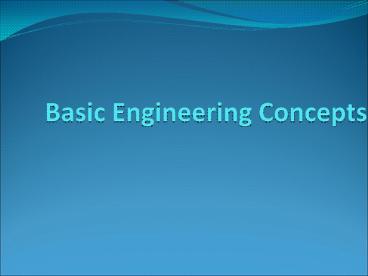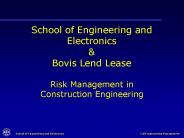Basic Engineering Concepts - PowerPoint PPT Presentation
1 / 28
Title: Basic Engineering Concepts
1
Basic Engineering Concepts
2
Scope of the presentation
- Scope of this presentation is to learn below
engineering concepts - Gravity
- Weight
- Mass
- Force
- Note All the above engineering concepts are
interlinked with each other.
3
Gravity
- Newton was the first person to seriously study
gravity - Gravity is a force that attracts all objects
toward each other. - The force of gravity is measured in units called
Newtons (N).
4
Gravity
- The strength of gravity between two objects
depends on two factors - 1. Masses of the objects (If mass increases,
force also increases) - 2. Distance between the objects (If distance
increases, force decreases)
5
Gravity
- The greater the mass, the greater the force
- The greater the distance, the less the force
- Acceleration due to gravity 9.8 m/s/s or 9.8
m/s2
6
Mass and weight
7
Mass Vs Weight
MASS WEIGHT
Is the amount of matter in an object is the force of gravity on an object
Always remains constant Weight of an object changes if the gravity changes
Does not depend on gravity Weightmass X Gravity
8
Measuring unit for Mass
- Mass is measured in
- grams and kilograms.
- 1 paper clip 1 gram
- 1000g1 kilogram
9
(No Transcript)
10
Force
- A force is a push or a pull.
- Force gives an object the energy to move, stop
moving, or change direction. - When you write with a pen you exert a force. When
you peddle your bike, blow your nose, chew your
gum, or swimming in a pool, you are exerting
forces on other objects. - We would never be able to move without exerting
forces on things
11
Newtons 2nd Law Fnet m a
- The acceleration an object undergoes is directly
proportion to the net force acting on it. - Mass is the constant of proportionality.
- For a given mass, if Fnet doubles, triples, etc.
in size, so does a. - For a given Fnet if m doubles, a is cut in half.
- Fnet and a are vectors m is a scalar.
- Fnet and a always point in the same direction.
- The 1st law is really a special case of the 2nd
law (if net force is zero, so is acceleration).
12
What is Net Force?
F1
When more than one force acts on a body, the net
force (resultant force) is the vector combination
of all the forces, i.e., the net effect.
F2
F3
Fnet
13
Net Force the 2nd Law
For a while, well only deal with forces that are
horizontal or vertical. When forces act in the
same line, we can just add or subtract their
magnitudes to find the net force.
32 N
15 N
10 N
2 kg
Fnet 27 N to the right a 13.5 m/s2
14
Normal force directions
- Up
- Youre standing on level ground.
- Sideways
- A ladder leans up against a wall.
- At an angle
- A race car takes a turn on a banked track.
- Down
- Youre in a roller coaster at the top of a loop.
15
Question 1
- Find out the forces?
Weight (N)
Reaction Force (N)
16
Answer for Question 1
- The first force is weight, and weight always acts
from the centre of the object. (strictly it acts
from the centre of mass, for example a lollipops
weight would be labelled approximately at the
centre of the sweet, rather than the centre of
the stick, because the sweet is heavier than the
stick) - Reaction force acts at 90 degrees to the surface
at the point of contact between the surface and
the object. Therefore it is drawn acting from the
floor upwards, at the middle of the cat.
17
Question 2
- Find out the forces?
Weight (N)
Reaction Force (N)
Friction (N)
18
Answer for Question 2
- The reaction force always acts at 90 degrees to
the slope of the surface at the point where the
cat and roof meet. - Weight always acts down.
- Friction acts parallel to the surface, at the
point of contact between the object and the
surface.
19
Question 3
- Find out the forces?
Weight (N)
Reaction Forces (N)
Friction (N)
20
Answer for Question 3
- This reinforces the reaction force is at 90
degrees to the surface at the point of contact
as there are many points of contact.
21
Question 4
- Find out the forces on WHEELBARROW ?
Weight (N)
Reaction Force (N)
Friction (N)
Lifting Force (N)
22
Answer for Question 4
- Weight acts from the centre of the wheelbarrow
- Reaction Force acts from the point of contact
between the wheel and the ground, at 90 degrees
to the ground. - Friction acts parallel to the surface, at the
point of contact between the object and the
surface.
23
Question 5
- Find out the forces?
Weight (N)
Upthrust (N)
Wind Force (N)
Drag (N)
24
Answer for Question 5
- Weight acts down form the centre of the boat
- Upthrust acts like reaction force, except is the
equivalent for water. - Wind force pushes on the centre of the sail
- Drag acts like friction, except for water. It
opposes the direction of motion, and occurs in
water and air. Imagine riding a motorbike on a
still day, not even a breeze. When you speed up,
you feel a wind against your face. This is the
air pushing you back, and is called drag. The
same happens in water.
25
Question 6
- Find out the forces?
Weight (N)
Reaction Force (N)
Driving Force (N)
Drag (N)
26
Answer for Question 6
- Weight, acting downwards from the centre
- Reaction force, acting upwards at the wheels
- Driving force, forwards direction - simply
showing this force is forwards is sufficient. See
notes below for further details on this force. - Drag opposes motion
27
Question 7
- Find out the forces?
Weight (N)
Reaction Force (N)
Force (N)
28
Answer for Question 7
- Weight, from centre downwards
- Reaction, from ground upwards
- Wind and rain forces































